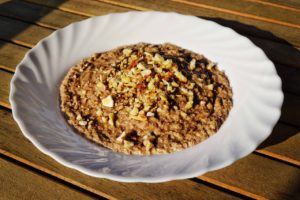Have you ever wondered what the laundry list of ingredients on your food’s nutritional label actually means? Unless you shop entirely along the perimeter of the grocery store and your diet is composed of 100% whole foods, nutritional labels have more than likely inspired frustration and confusion in your shopping. Packaged and labeled food have become so complicated it’s difficult to know exactly what it is you’re eating and what the best and healthiest choices actually are. Follow these 6 easy rules to make smart choices at the grocery store.
1. The first ingredient should match the label of your food! For example, if your product is labeled Mango juice, then the first ingredient should have the word “Mango” in it, not apple or orange juice.
2. If you can’t pronounce it – avoid it. There are a couple of exceptions but generally, unrecognizable means indigestible and potentially toxic chemicals or additives. The following often unrecognizable additives are safe:
A. Acids: Citric, sorbic and lactic
B. Alginates:Used as a gelling agent and for thickening drinks and cosmetics.
C. Carrageenan: Extracted from seaweed, this vegan alternative to gelatin has been used as a additive for hundreds of years.
D. Annatto: Derivative of a seed used as yellow to red food coloring and also as flavoring.
E. Casein and Lactose: Derived from mammalian milk.
F. Gelatin: Used as a thickening agent and derived from the collagen inside animal skin and bones.
G. Glycerin: Mostly found in supplements and prescirption drugs which helps them to be water soluble.
H. Lecithin: Readily bioavailable and non toxic, this additive is commonly used in a variety of products.
I. Monoglycerides: Formed from lipids and used to emulsify fats to make them water soluble.
J. Natural Flavorings: Pectin, sorbitol, vanillin
3. Avoid ALL of the following additives:
A. Hydrogenated fats: Also known as trans fats have been strongly associated with increasing the risk of cardiovascular disease. They lower “good” HDL cholesterol while raising “bad” LDL cholesterol.
B. Articial food colors: Especially FD&C Blue #1, FD&C Blue #2, FD&C Green #3, FD&C Red #3 (Erythrosine), FD&C Yellow #5 (Tartrazine) and FD&C Yellow #6
C. Nitrites and nitrates: Also known as Sodium nitrate/nitrate
D. Sulfites: sulfur dioxide, sodium sulfite, sodium and potassium bisulfite, sodium and potassium metabisulfite
E. Artificial sweeteners: Aspartame, acesulfame-K and saccharin.
F. MSG: Common food additive used to enhance flavors and preserve food.
G. Preservatives: Butylated Hydroxyanisole (BHA) and Butylated Hydroxytoluene (BHT) EDTA and THBQ
H. Artificial flavors
I. Refined flour
4. Be mindful of the amount of salt and sugar – each of these compounds function as PRO-oxidants in the body and should be ingested in rationed quantities.
On average, Americans eat approximately 8 grams of sodium a day. The ideal intake should be around 2 grams with a Potassium to Sodium ratio of 2:1. That means at least twice as much potassium as sodium each day.
Women should consume no more than 30 grams of sugar per day while men should stay well below 45 grams.
5. Look for high amounts of fiber, vitamins, minerals and nutrients. For example, each whole grain bread should have at least 3-4 grams of fiber. Aim for a minimum of 20-35 grams of fiber per day.
Another bonus are fortified products such as almond milk and yogurt containing additional calcium and vitamin D.
6. Support Eco-conscious practices such as organic, fair trade and compostable packaging. These efforts have a positive impact on both our health and the environment.
Author: Dr. Karen Lamb, NMD, LPC
Photo by Laura James from Pexels





Hello puravidanaturalmedicine.com admin, Your posts are always well-received by the community.